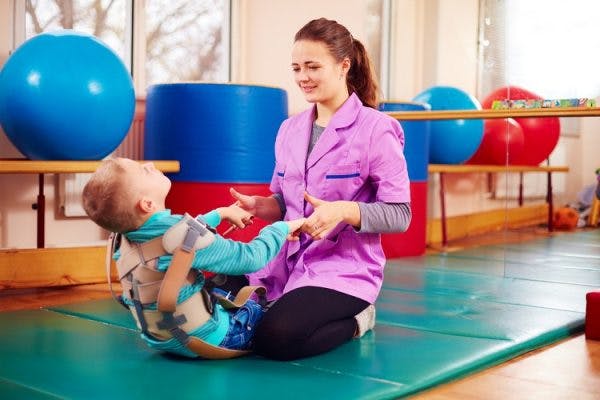Some types of cerebral palsy can cause individuals to experience tremors. A tremor is an “involuntary, rhythmic, and oscillatory movement” that can occur in any area of your body. Tremors can make it challenging for individuals to grab items and perform everyday activities. Fortunately, many individuals with cerebral palsy are able to effectively manage their tremors and live a high quality of life.
To help you understand the association between cerebral palsy and tremors, this article will discuss:
Causes of Tremors in Individuals with Cerebral Palsy
Tremors are most commonly associated with ataxic cerebral palsy. This is the least common type of CP, making up about 5% of all cases. It is caused by damage to the part of the brain called the cerebellum, which is responsible for balance and coordination skills.
Individuals with ataxic cerebral palsy often experience intention tremors. This is a type of action tremor that occurs when you try purposefully to move from one point to another. Intention tremors worsen as you get closer to your target. As a result, they make it more challenging to perform tasks that require fine motor skills such as writing and using silverware.
Depending on the location of cerebellum damage, intention tremors can occur in one or both sides of the body. Damage to the right side of the cerebellum can cause tremors in the left side of the body and vice versa. Additional effects of damage to the cerebellum will be described in the following section.
Symptoms That May Accompany Tremors in Individuals with Cerebral Palsy
Damage to the cerebellum can cause further secondary effects in addition to tremors. Everyone experiences ataxic cerebral palsy differently, so it’s essential to be aware of other potential effects.
Other symptoms associated with cerebellum damage that may co-occur alongside tremors include:
- Gait abnormalities (typically a wide-based gait)
- Poor coordination and balance
- Dizziness
- Fine motor problems
- Low muscle tone
- Speech difficulties
It’s key to work with a team of medical professionals to identify the effects of cerebellum damage and appropriately manage them. Many times, the severity of tremors and other secondary effects of ataxic cerebral palsy can be improved through early intervention.
Cerebral Palsy and Tremor Management

Fortunately, the brain damage that causes cerebral palsy will not worsen over time. However, if left unmanaged, symptoms can progress and significantly affect an individual’s quality of life. Therefore, it’s essential to focus on minimizing secondary effects of cerebral palsy (such as tremors) and learning effective ways to maximize your functional abilities.
Some of the most effective ways to manage tremors in individuals with cerebral palsy include:
Physical Therapy
Physical therapy will help individuals with ataxic cerebral palsy improve their gross motor functions through targeted balance and coordination exercises.
Tremors can make it challenging to move effectively, which can discourage individuals with cerebral palsy from attempting movements that require coordination. Gross motor coordination problems can cause difficulties not only with walking but also with the motions required for many outdoor activities and games, including jumping, skipping, throwing, and kicking.
If you don’t practice using your coordination skills, they cannot improve. Therefore, physical therapy for tremors will focus on massed practice of appropriately challenging coordination tasks. While tremors may not go away, the continuous stimulation provided by targeted exercise can help individuals get more comfortable moving around and working with their tremors.
Occupational Therapy
At occupational therapy, individuals with tremors focus on learning how to improve their functional mobility and independence by practicing activities of daily living. Consistently practicing activities of daily living like getting dressed, brushing your teeth, and using silverware can help individuals with ataxia develop their fine motor skills.
An occupational therapist may also teach you how to use adaptive equipment like reachers, adaptive utensils, and button hooks to be more independent. Oftentimes, utilizing weighted utensils can minimize the effects of tremors to allow individuals to do things such as eating and writing more easily.
Medications
Unfortunately, a long-term pharmacological treatment for intention tremors has yet to be established. While medications can help temporarily reduce the severity of tremors, they are not recommended for long-term use due to potentially harmful side effects.
Common medications used to treat tremors in individuals with cerebral palsy include:
- Beta-blockers (Propranolol)
- Anti-convulsants (Carbamazepine, Clonazepam, Gabapentin, Levetiracetam, Primidone, Topiramate)
- Dopamine Promoters (Ropinirole, Amantadine, Levodopa, Pramipexole)
- Benzodiazepines (Diazepam, Alprazolam, Clonazepam)
- Botox Injections
For your child’s safety, make sure that your child’s pediatrician is aware of all other medications your child is taking. Some medications do not react well when taken together.
Tremors in Individuals with Cerebral Palsy: Key Points

While tremors are most common in individuals with ataxic CP, those with other types of CP can also experience them. Many people with mild tremors learn how to effectively manage and prevent them from significantly interfering with their everyday lives. With repetitive practice, individuals can learn to work with their tremors and improve their mobility.
We hope this article helped you better understand why individuals with cerebral palsy may experience tremors and how to manage them.











